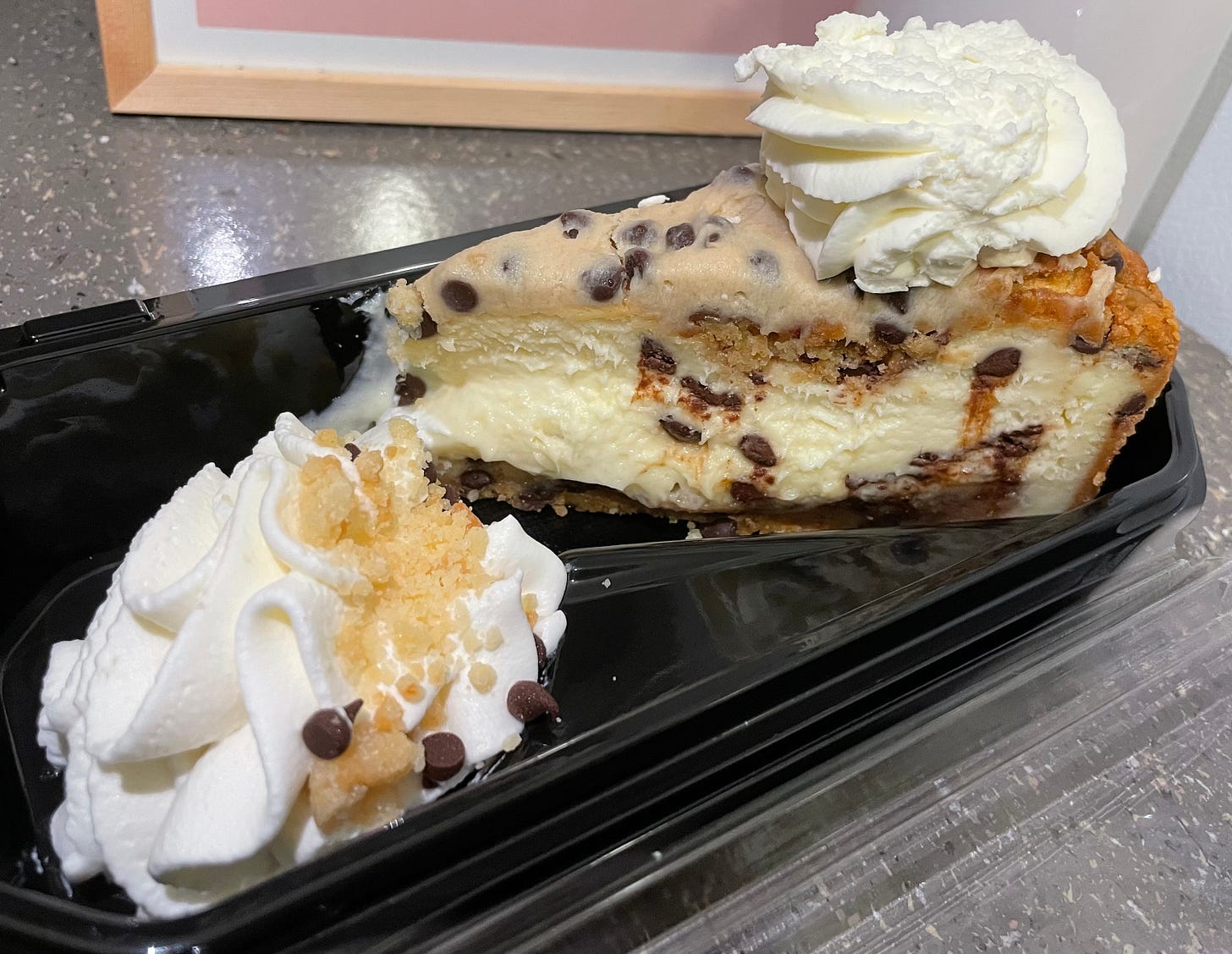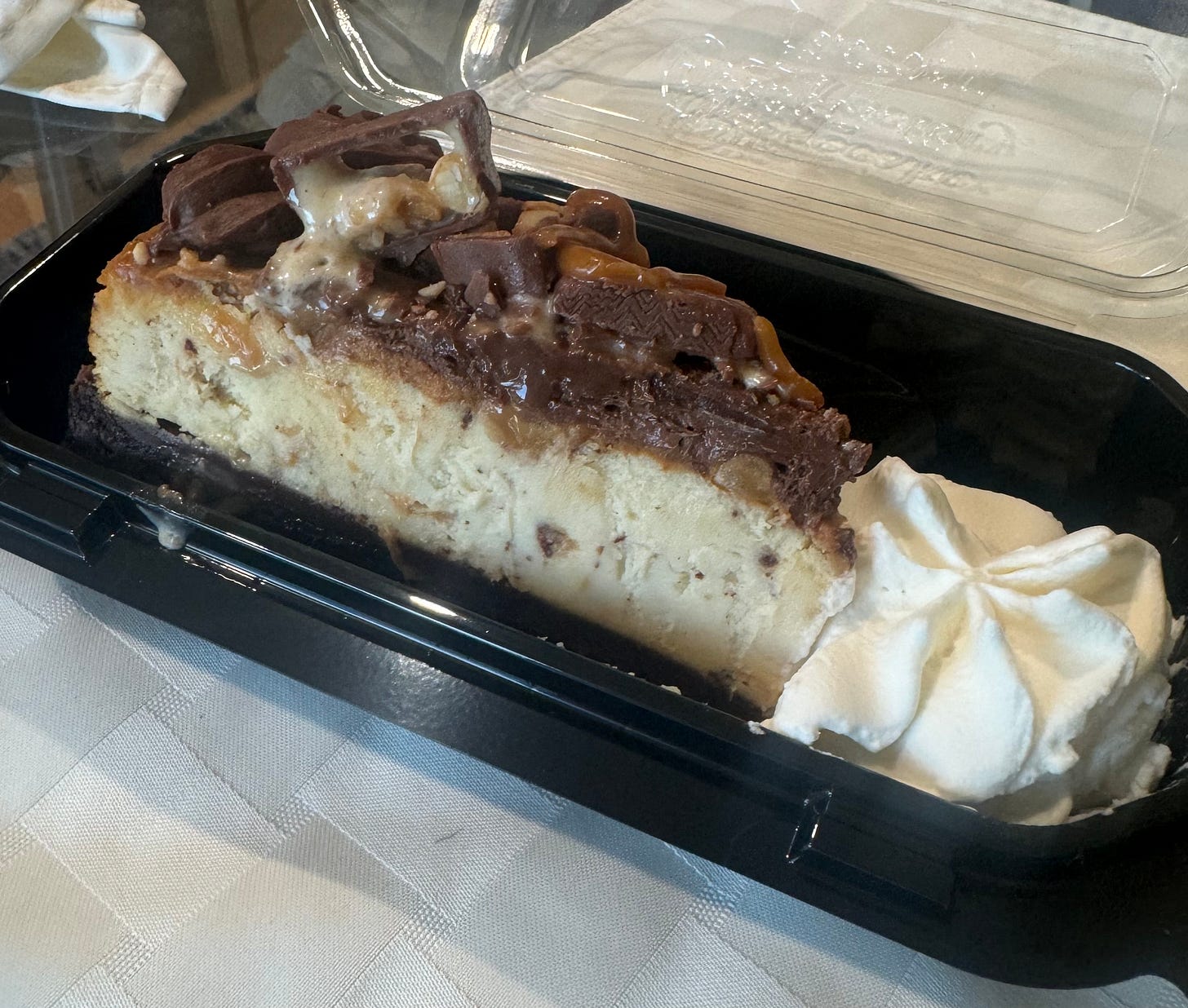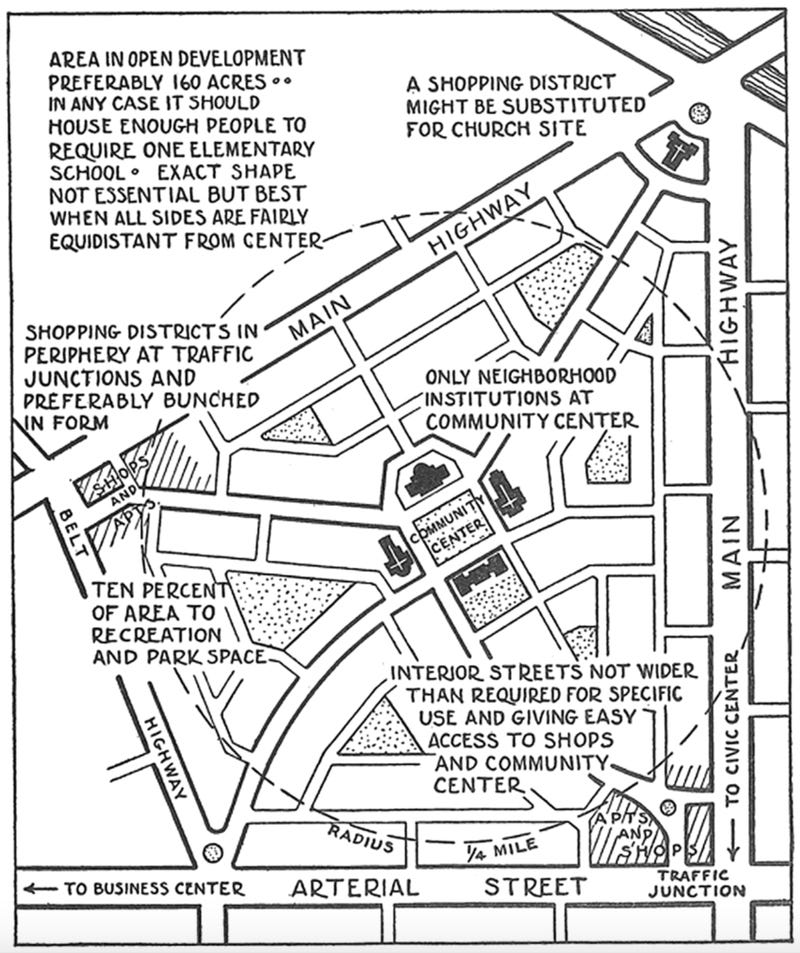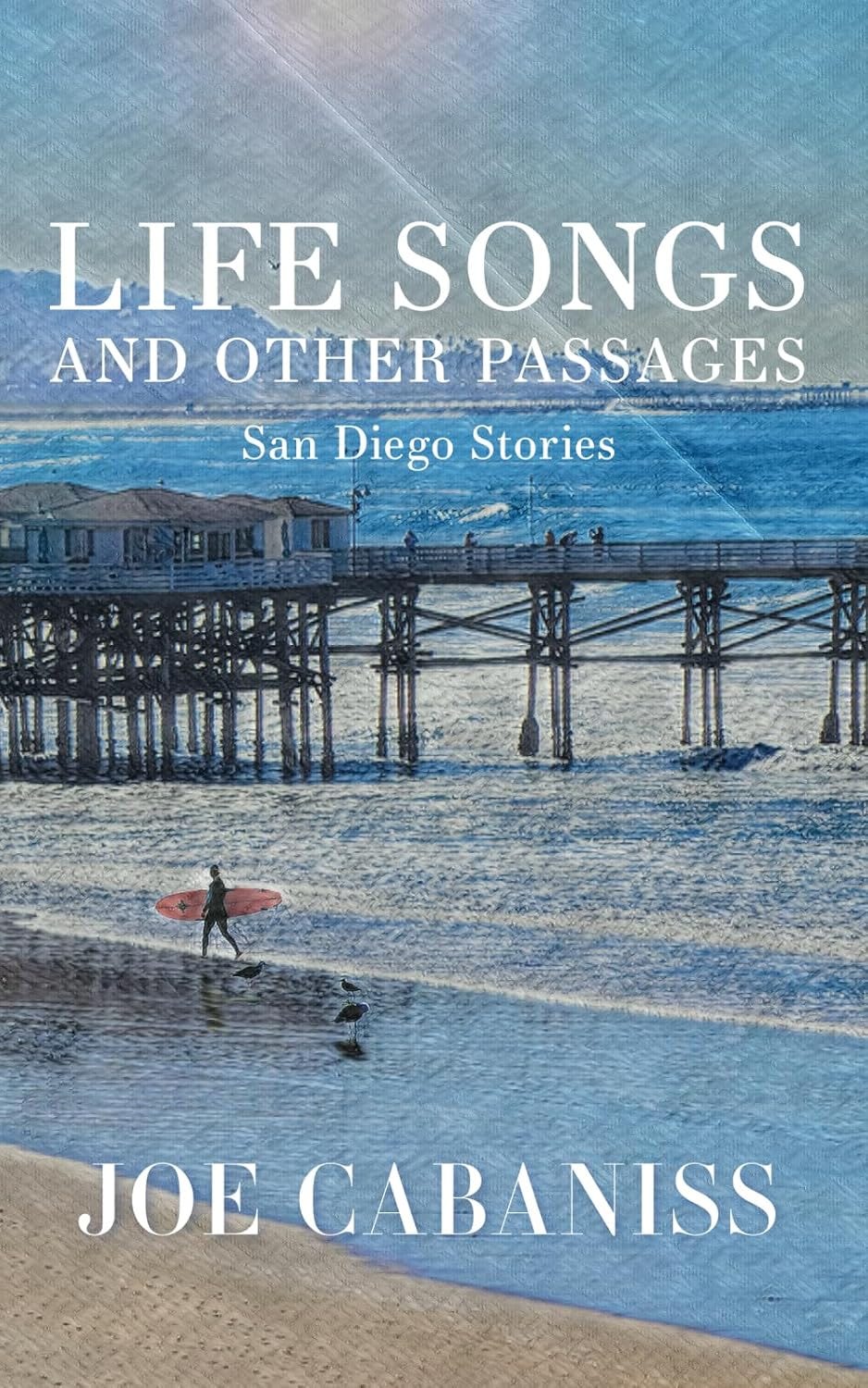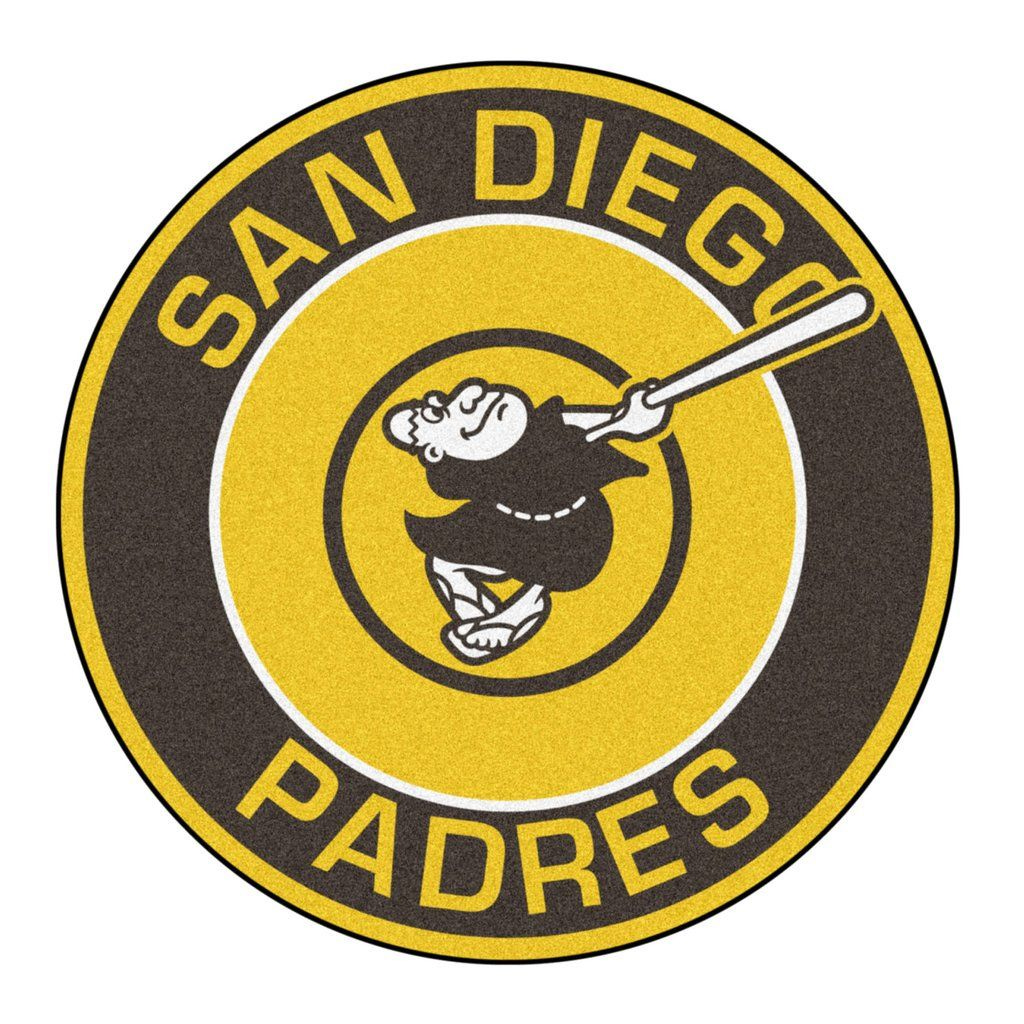A Favorite Local Restaurant to Close
Plus: Celebrating National Cheesecake Day, The Spiritual Godfather of Linda Vista, Book Published by Kearny High Grad, and, How to Describe the Padres' Season
On August 15, 2024, my wife and I will observe a moment of silence. We will use this moment of silence as a way of honoring one of our favorite local eating establishments, for August 15 will be the last day of business for Perry’s Cafe.
We recently discovered that Perry’s Cafe, located at 4620 Pacific Highway and just outside the borders of Linda Vista in Old Town, will be closing its doors after nearly 40 years of serving great breakfast meals. Opened in 1985, it was described on one internet source as a cafe that “quickly established itself as a beloved destination for locals and tourists alike looking for classic American diner fare, generous portions, and friendly service. The cafe's iconic retro decor, featuring leather booths, a diner counter bar and nostalgic memorabilia, creates an ambiance that harkens back to a bygone era.”
According to the publication, a new residential building complex will be built on the 1.74 acre property. This residential building will be a 224-unit, seven-story residential tower “with a mezzanine level over a two-story podium, an above-grade parking area and one partial level of below-grade parking. A portion of Perry’s Café is expected to remain and will be repurposed as part of the project.”
The Linda Vista Update published a review of Perry’s Cafe back in our December 1, 2022 issue. In that review, we entertained the question… “Does Perry’s offers the best breakfast in town?” We also commented on how the restaurant offers an “old time diner feel right in your own (Linda Vista) back yard.” As another news article commented, “It's like a second home for a lot of people, they like to come here for breakfast because it feels like they’re coming home to a home-cooked meal," We considered it the place to go on those occasions when a stronger than usual morning hunger demanded large meal portions, or when we felt the need to enter a time portal and return to the feel of the 1950’s or 1960’s.
In addition to losing the opportunity to enjoy that great food and atmosphere, we will also miss the architecture. We believe the building’s style is representative of the “Googie” style of architecture that was popular here in Southern California during the late 50’s and early 60’s. The style is a bit futuristic in design and often featured “bold geometric shapes with sharp angles and sweeping curves.” The style reflected such things as jets, rockets, cars and the Atomic Age and demonstrated the promise of that pre-Vietnam War era. We hope the new apartment building is successful in being able to preserve that feature of the original building destined to remain for repurposing (As an aside, the Googie architecture present in the entrance to the old Scottish Rite Temple in Mission Valley is thankfully being preserved as the structure gets converted to a Home Depot).
We accept that change must occur and that such things as more housing units are much in demand, but we will definitely mourn the passing of this local institution.
Preparing for National Cheesecake Day
How many of you know July 30 is National Cheesecake Day? I’m not really a big fan of cheesecake, but Steve loves it. And, as much as I like to bake, I have never mastered the art of making cheesecake. But this week we knew we had to conduct a pre-celebration of the upcoming day, so we thought and thought about exactly where we might find cheesecake in our neighborhood for the purpose of alerting our readers of this special and delicious day. After thinking and thinking, we looked over our balcony and lo and behold, right below us, staring us in the face, was The Cheesecake Factory, at the Fashion Valley Mall. We actually hadn’t been there in years, and very rarely tried their cheesecake. If my recollection serves me correctly, the portions on the meals were so big, that by the time we finished our meals, we were not hungry enough to eat a slice of cheesecake.
To remedy that complication, this time we decided to just order cheesecake and bring it home. We recruited our Carnivore Sidekick and his sidekick to help us with this task. Of course, it really didn’t take much for them to say yes.
In looking at their menu for cheesecake, it was very hard to decide which flavor to pick. I love Snickers bars and they have a Chocolate Caramelicius cheesecake made with snickers. This is an original cheesecake swirled with Snickers on a brownie crust with chocolate, caramel and peanuts. Steve and I decided to split this generous slice.
The Carnivore went with a cookie dough lovers cheesecake loaded with chocolate chip pecan cookie dough topped with cookie dough frosting.
His sidekick’s selection was the Original Cheesecake which is their famous creamy cheesecake with a graham cracker crust and sour cream topping. Her feeling was that you can’t improve on a classic cheesecake.
Steve and I cut our slice into 4 smaller pieces when we noticed it had 1370 calories and about a billion grams of sugar. It was delicious, and we will enjoy it again for dessert tomorrow and maybe the day after. Caramel, chocolate, whipped cream, peanuts, brownie crust. What’s not to love? The cheesecake was particularly creamy and smooth.
The Carnivore loves cookie dough. When I am baking cookies he always asks for the dough, which I don’t really think is good for you. His slice was 1550 calories, but then, he’s young. He eventually said the cookie dough cheesecake didn’t disappoint. It had a substantial amount of cookie dough, but didn’t overpower the cheesecake which was, of course, delicious. The chocolate chunks added more chocolatey flavor. Perfect for a cookie dough lover.
The CS’s sidekick was the only smart one. Her classic cheesecake is only 830 calories. I can’t believe I said “only” and “830 calories” in the same sentence. She said the original was surprisingly flavorful; and commented that she has eaten a lot of cheesecakes in all different flavors, but this was by far the best and creamiest she’s ever had.
On the good side, these slices ranged from 15 to 19 grams of protein each. Won’t even mention fat, carbs, etc. You can look up those nutritional details on the internet. In my opinion, sometimes you have to throw caution to the wind. That one day a year when we celebrate National Cheesecake Day is one of those times. Next year, we will get one slice and split it four ways.
Local Historical Perspective
The Spiritual Godfather of Linda Vista
In last week’s issue of this newsletter we discussed a University of San Diego Master’s thesis (maintained in the Linda Vista library) that discusses the history of housing development in Linda Vista during the 1940-1954 era. One of our readers subsequently responded by letting us know about another document published in 2010 for the San Diego Redevelopment Agency that addresses the history of the Tenant Activity Building constructed in 1943 “on lot 5 of block 54 of unit 1 of the Linda Vista Subdivision.” This building, located at 6907 Linda Vista Road, is now occupied by Skateworld.
In reading this interesting document and learning more about the origins of Linda Vista, we were fascinated to learn a few things. First, we learned the Tenant Activity Building was built to “serve the community and recreational needs of the residents of the Linda Vista Housing Project.” Much to our surprise, we found out it was built and designed separate from the Linda Vista Mall. History repeats itself as the community could use such a versatile building today for the same purposes.
We also learned about the influence of an individual from New York named Clarence Perry. The document notes that in planning the development of Linda Vista beginning in 1940, the City planners “designed the site plan with a focus on the application of Neighborhood Unit Theory principles.” What were those principles and where did they come from? The Neighborhood Unit Theory was developed by Perry and addressed six principles: size, boundaries, open spaces, institution sites, local shops, and an internal street system. These principles involved such concepts as devoting ten percent of a neighborhood area to parks and recreation space, and having a number of community buildings/resources within a five minute walk from residences (five minutes being the maximum distance before people resort to driving a car). Below is a sketch of a neighborhood unit designed by the theory’s founder, Clarence Perry. It emphasizes the relationship between walking distances and non-residential community structures/features.
We learned that Clarence Perry came up with his theory in 1929, and according to one internet source, by doing so, he “laid the foundation for modern-day planning movements including the “new urbanism” movement of the ’80s, ’90s, and today.”
In this sense, we might say that Clarence Perry is the spiritual godfather of Linda Vista. His influence played a major role in 1940, and we continue to feel the effects of his influence in Linda Vista today.
We also learned about the influential role played by another planner named Sherwood Reeder. He was a planner who beginning in 1936 helped design the planned community of Greendale, Wisconsin. This greenbelt community was built on the principles of Clarence Perry’s theory and emphasized housing situated within easy walking distance of gardens, employment and the town center. In 1940 Reeder left Wisconsin and came to San Diego to help plan the Linda Vista development. Later in the same decade he went on to help develop/manage city plans for Cincinnati, Ohio and Richmond, Virginia.
Finally, the document inspired us to conduct a bit of research on the Linda Vista Mall. As many LV residents know, the Linda Vista Mall is in the Mall Hall of Fame. We visited this internet venue and found a photo of the Linda Vista Mall from 1945. We then found another site from the Huntington Library with even more photos of the Mall. The photos, by photographer Maynard Jackson, are quite impressive, depicting the Mall as a futuristic site—a far cry from what exists there today. It’s too bad the site could not be preserved in that form.
The Huntington Library wrote this about the photographer … “From the sun-drenched patio and outdoor barbeque, to the living rooms of some of Hollywood’s legendary celebrities, photographer Maynard Parker (1900-1976) captured Southern Californian culture that came to dominate a mid-century modern architectural aesthetic. Based in Los Angeles for most of his life, Parker is known for his landscapes and depiction of postwar suburban homes celebrating indoor-outdoor living and a burgeoning consumer culture.”
You can check out the rest of the photos by clicking here.
***
We wish to thank Linda Vista resident Elena Barreiros for letting us know about the document that details the history of Linda Vista’s Tenant Activity Building.
Kearny High Grad Publishes Book
A 78 year old alum of Kearny High (Class of 1963) recently had his book published. The book, titled Life Songs and Other Passages: San Diego Stories, is a collection of vignettes/short stories written by Joe Cabaniss. The book was reviewed this past Sunday in the San Diego Union Tribune. You can read the review here.
The fictional stories compiled by Cabaniss are held together by such themes and topics as surfing, the struggles of growing up in a family led by a Navy father, a young man trying to impress girls, and coming of age during the tumult of the 60’s and early 70’s. The author’s love of surfing as well as the haunting specter of the Vietnam War are present in many of the stories.
Upon learning the author was a Kearny grad, I opened the book hoping to see some vivid descriptions of 1960’s Linda Vista and the surrounding areas, but Linda Vista is mentioned only once in passing, and there are few physical descriptions of the surrounding communities. Cabaniss reserves most of his descriptions for surfing, girls, family dynamics, and academic struggles.
Cabaniss is a retired local journalist who now resides in Alpine.
Commentary
Finding the Right Words for Padres Season
We are now past the half-way point of this year’s Padres baseball season, and I find myself struggling for the right words to describe how I feel about the team’s performance so far and the prospects for getting into the playoffs—even if it’s done via a mere wildcard spot. I had high hopes at the beginning of the year, with dreams that the Padres would be far ahead in first place, but the Padres have spent the entire season trailing the dreaded L.A. Dodgers, and they continue to hover around the .500 mark. Some days they are a few games above .500. Then sometimes they fall a couple games below .500. And then sometimes they are exactly at the .500 mark. Frustrating. Yes. Heartbreaking? Not yet. I have not given up hope.
In the meantime, the Arizona Diamondbacks and San Francisco Giants appear to be gnawing their way up the standings, and threaten to overtake the Padres’s second place conference position. Needless to say, a .500 winning percentage is not the place to be if you want to guarantee yourself a playoff spot.
In describing the season so far, I hate to use a word like “disappointing”—that sets too negative a tone. At the same I hate to use a word like “hopeful”, because I don’t want to end up sounding foolishly naive. In other words, I want to appear realistic without sounding even remotely as if I have given up on the team.
Recently, I did come across an expression that might work. While shopping in Linda Vista, I asked a person how he thought the Padres were doing. He responded by saying with a slight smile on his face… “Fair to middlin’.”
Though I had heard this old expression many times before, there was something about it that immediately intrigued me this time as an appropriate way to describe the Padres’ season. I looked the phrase up once I got home. According to an online dictionary, the phrase “fair to middlin’” can mean “above average” or it can mean that something “isn’t terrible and it isn’t great—it’s mediocre.” It offers a range.
Right now, the Padres are indeed playing like a “mediocre” team, but that doesn’t mean that all hope for the season is lost. In fact, sometimes their performance attains a “slightly above mediocre” level of “fair”. And so one can say the term “fair to middlin’” provides the proper degree of linguistic flexibility that Padres fans need to keep the faith while also staying real.
I did briefly consider other expressions/words to describe the Padres season. When asking one young person “What do you think of the Padres season?” he responded curtly with the word “Meh”. This expression, popular among young people, is often delivered with a shrug to signify either “It’s unexceptional” or “I couldn’t care less.” However, I believe the curtness and shrugging shoulder thing ultimately reeks too much of cool hipster apathy. It’s still too early in the season to be apathetic, and I could never be a cool hipster.
And I also thought about the Spanish expression of “así así” which equates to “so-so” in English. But “so-so” emphasizes mediocrity without highlighting any prospects of future improvement.
For now I am sticking with “fair to middlin’”. I like the modest, realistic range of possibilities offered by this saying. And, after all, that’s what America is all about, right? Offering a range of possibilities with the strong possibility of upward mobility.
Who knows? If the Giants and Diamondbacks falter, and all the stars align correctly, then being “fair”, (which in this case can mean a reasonable few games above .500) might be all that’s needed to get the team to a wildcard playoff spot.
Subscribe to the Linda Vista Update
We invite everyone to subscribe to the Linda Vista Update. It’s free! Just click on the “Subscribe now” button located below.
The Linda Vista Update is a weekly digital newsletter that publishes informative, interesting and fun news about Linda Vista and its neighboring communities.
We welcome ideas for stories. Let us know about any interesting people, places, or upcoming events.





